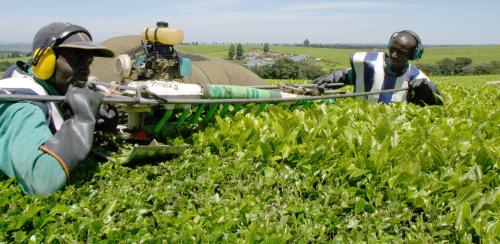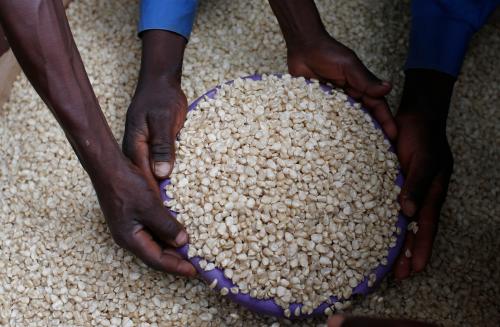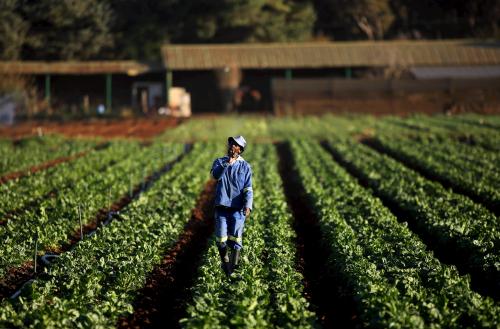Evidence of Nairobi’s ascendance to the status of major urban center, as is the case with other big cities on the continent, can be found in its near constant gridlock on the roads. And one common feature amid the long lines of crawling cars are roving “hawkers,” typically young transplants from the countryside, weaving in and out of traffic selling an assortment of cheap trinkets, like pens and pencils and small toys.
Occasionally I ask one of them, “Why did you come to the city?” and the answer is typically some version of “because there was nothing for me to do in the village.” Since village life in Kenya and most of sub-Saharan Africa is dominated by agriculture, what they mean is that they saw no future in farming.
That’s hard for someone like me to hear. My career is dedicated to finding a way for agriculture to be a source of income and employment on a continent where economic opportunity can be as scarce as rain in the arid lands of East Africa. Yet, every day, I encounter young Africans who find more opportunity in being street hawkers in Nairobi than farming back home.
Their migration to the cities re-enforces a message many people and governments are starting to heed. While agriculture in Africa often is discussed in the context of hunger and malnutrition, the only way for agriculture to become a source of food security is to ensure it also becomes a source of economic security.

For decades, Africa’s food challenges were viewed primarily through the prism of production challenges—and for good reason. On most African farms, yields of rice, maize, and other staple crops—the amount harvested per acre or hectare—are often less than half of what farmers elsewhere in the world produce.
There are several factors behind these substandard harvests. Many African farmers lack the basic things many farmers outside the region take for granted, like access to improved crop varieties, fertilizers, and irrigation. Although some progress has been made, addressing these weaknesses by themselves is not enough.
Even when subsidized, farmers have no incentive to invest in the means to boost their yields if they have no way to earn income from their hard work. So they either continue doing the best they can with what they have, or they put down the hoe and head to the city.
Making markets work for agriculture
Whenever I visit the countryside in Kenya where I grew up, I often see that even families who own five hectares of land are planting crops on only one. Why? Because their children, once a reliable source of farm labor, have moved away to Nairobi or other urban centers. At the same time, I do see food production rising in Kenya and elsewhere in sub-Saharan Africa in places where agriculture development initiatives are simultaneously addressing production and marketing challenges.
For example, cassava production is reliably rising in parts of Nigeria, Tanzania, Uganda, and Malawi. In these countries, new processing facilities have been established to meet new demand for cassava as an ingredient in everything from baked goods and beer to paper, board, and plywood. In Rwanda, Tanzania, and Zambia, sustainable increases in crop production are occurring on small-holder farms that have contracts to grow maize and other crops for the U.N. World Food Program. In Ghana, rice yields are rising on small-holder farms that have joined an initiative to grow rice for a domestic food company, which is providing consumers in Ghana with a cheaper alternative to imported rice. Crop clusters around a processor have proved very effective.

This kind of agriculture development is generating economic opportunities in rural communities on and off the farm. For example, in rural Nigeria today, young people who don’t want to farm increasingly have the option of working nearby at a cassava processing facility. In Kenya, I meet young adults who once saw farming as a career of last resort but are now drawn to the business proposition of adopting tech innovations to grow high-quality, high-value produce in greenhouses. Access to affordable finance, coupled with efficient markets, is key to this end.
On the one hand, the lesson here is that the long-term solution to hunger and malnutrition in sub-Saharan Africa is more complicated than many may have imagined. It requires addressing multiple weak links in what is sometimes called the “value chain” of food production.
But there is a major upside to the value chain approach to agriculture development. The investments most likely to increase food security in Africa will also increase economic opportunity. And on a continent where some 233 million are undernourished but more than twice that many earn a $1.90 or less a day, it’s clear the two issues are inseparable.
Solving Africa’s food production problems by expanding the economic possibilities of the agriculture sector might mean there are fewer hawkers to offer car-to-car retail services in the Nairobi traffic snarl up. But if we can generate investments, partnerships, and policies to grow an abundance of both good jobs and good food, maybe solving Nairobi’s traffic problems can be next on the list.
Note: Anne Mbaabu is Head of Markets at the Nairobi-based Alliance for a Green Revolution in Africa (AGRA). This blog reflects the views of the author only and does not reflect the views of the Africa Growth Initiative.
The Brookings Institution is committed to quality, independence, and impact.
We are supported by a diverse array of funders. In line with our values and policies, each Brookings publication represents the sole views of its author(s).







Commentary
Encountering Africa’s agriculture challenges in its cities’ morning traffic
March 29, 2017